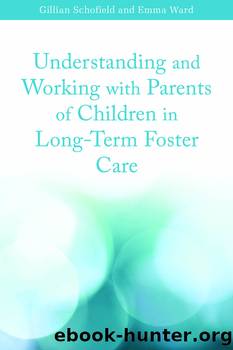Understanding and Working with Parents of Children in Long-Term Foster Care by Ward Emma;Schofield Gillian;

Author:Ward, Emma;Schofield, Gillian;
Language: eng
Format: epub
Publisher: Jessica Kingsley Publishers
Sibling groups
One of the most powerful features of accounts given by parents was the impact of complex sibling groups on their efforts to manage their role as parents and their relationships with their individual children, and this was particularly evident at contact.
In all families, parentsâ feelings about each of their children may vary. Responding to childrenâs different personalities and meeting their different needs, being fair to each child, is a challenge for any parent. Siblingsâ feelings about each other, for example, and about which child is seen as favoured or rejected by parents, also run deep and can last into adulthood.
However, these ânormalâ family tensions are played out in very complicated ways for parents and children when, for example, there are six children in a sibling group of whom the eldest lives with an ex-partner, the next eldest child has left care and is at home, the two next children are in long-term foster care and the youngest is about to be adopted. What is more, in most, but not all, of these larger families, children were from different fathers, which added additional emotional and loyalty dynamics to the mix. Even where children were from the same father, some children were apparently favoured, which left already anxious, separated children feeling distressed and angry.
Their dad is still close to Malcolm. He sees him once every fortnight on a Saturday. He has got a bond with Malcolm, because he is sixteen and he can have a chat with him, take him out and places and he go and whatever. But for the other three he hasnât bought Christmas presents, birthday presents and that is why Jake is so angry now, because he thinks that his dad hates him. (Lorraine)
Although for some sibling groups all children were in long-term foster families, combinations of different placement types were not unusual. And even where children were in the same placement type, contact arrangements and relationship quality could, of course, vary. Tina and Derek had diverse contact arrangements with their children that did not make too much sense to them, and then an older child was returned to them. Although the needs of their children of different ages and in different placements were different, from their point of view the arrangements were hard to accept.
I have to see two of my kids under supervised access and the other two, one lives here and one comes here daily, so it just seems crazy really.
Although the goal of having the siblings together for contact with parents was often shared by social workers and parents (as it allowed the family to be a family, gave siblings contact with each other and was efficient for everyone in terms of time) it was often seen by parents as not necessarily meeting their needs or the needs of individual children. Sometimes, this was because the time was just not enough, as this father describes.
I was seeing them altogether, all six of them at once. But I have now asked for that to
Download
This site does not store any files on its server. We only index and link to content provided by other sites. Please contact the content providers to delete copyright contents if any and email us, we'll remove relevant links or contents immediately.
Doing It: Let's Talk About Sex... by Hannah Witton(9080)
Thirteen Reasons Why by Jay Asher(8452)
The Girl Without a Voice by Casey Watson(7604)
Should I Stay or Should I Go? by Ramani Durvasula(7430)
The Incest Diary by Anonymous(7421)
The Lost Art of Listening by Michael P. Nichols(7160)
The Leavers by Lisa Ko(6806)
The Space Between by Michelle L. Teichman(6576)
The Testaments by Margaret Atwood(6501)
The Four Agreements by Don Miguel Ruiz(6319)
Rich Dad Poor Dad by Robert T. Kiyosaki(6179)
The Rosie Project by Graeme Simsion(5840)
We Need to Talk by Celeste Headlee(5415)
Beartown by Fredrik Backman(5359)
Men In Love by Nancy Friday(4964)
Ego Is the Enemy by Ryan Holiday(4958)
Spare by Prince Harry The Duke of Sussex(4788)
Hunger by Roxane Gay(4678)
Suicide Notes by Michael Thomas Ford(4651)
